I flattened myself against the soot-stained wall and made a fervent wish that I would not get burned. The temperature in the room was up in the 40°s and Antoine was wielding his long metal bar in a dance with the flames: darting in to turn the giant iron tray; pulling back from the spitting oil. His attention was thoroughly focused on the task in hand: cooking socca, the chickpea pancake that is the pride of the people of Nice, and enjoyed all along the French Riviera. As I took photographs, I wondered briefly whether I ran the risk of melting the casing of my camera.
Making socca for a hundred years
Chez Theresa is a restaurant in the heart of Nice’s old town – although the term ‘restaurant’ may be somewhat misleading. The enormous, wood-fired oven where Antoine was working was located in a part-kitchen-part-bar, and helpings of fresh socca were being thrust unceremoniously through a hatch to waiting customers outdoors. While the names of a couple of other Niçois snacks were scrawled on a blackboard, there was little evidence of them being served. Out front, at a couple of unadorned, wooden trestle tables set up in the narrow pedestrian alley, people were munching their portions of golden pancake from paper plates – with no cutlery in sight. Socca is only ever to be eaten with fingers. Chez Theresa has been an institution in Nice since the indomitable Theresa opened her doors in 1925. Now it is one of only 3 places left in the city where socca is still made traditionally, in a wood-fired oven.
I hadn’t heard of socca until I came to the South of France and moved to the hills above Nice. There, in the cool shade of lime trees in the square of my little town, I first tasted its gooey-yet-crispy delights. Kamel tows his portable oven there twice a week to make it, and once I’d tried, I was hooked: socca became a regular fixture in my life. The dish isn’t exclusive to Nice: a close relative can be found along Italy’s Ligurian coast (‘farinata’) and variant recipes are found all over the eastern Mediterranean. Yet Nice’s own version of the pancake is unique, particularly thin and crisp, and it is the only one bearing the name ‘socca’.
Working class fuel
The geographic specificity of this dish is a testament to Nice’s own, rather individual, identity. Previously separate from the rest of the country, Nice was under the protectorate of the state of Savoy until a referendum saw it handed over to France in 1860. Even today, le pays Niçois [the Nice country] identifies neither as truly French nor even Provençal, and its cuisine is no exception. Its great range of traditional recipes were born from arid, steep land; poor soils; and hot, dry summers – along with the plants, herbs and animals that can survive there. Chickpeas and olives, socca’s main ingredients, are two prime examples. Today, the Côte d’Azur may be a magnet for wealth and leisure-seekers, but in the past, the region was notoriously poor and Niçois pride is flavored with working class, independent values. For those who look, the city’s flag portraying a red eagle watching over 3 hills can still be glimpsed flying; for those who listen, down by the harbour, in backstreets or at an OGC (the city football club) match, the dialect Nissart is still spoken. A fresh salade niçoise may be loved by visitors and locals alike, but as a culinary symbol for the people of Nice, a filling, cheap snack traditionally sold by street vendors to fuel a working day is a better fit.
Military value of chickpeas?
Legends about the origin of socca are diverse – and seem tenuous. One says the cooking method was invented by Roman soldiers who roasted chickpea flour on a shield; others say the recipe was discovered in 1543 during the Siege of Nice. Short of ammunition, the Niçois supposedly mixed hot oil with chickpea soup and poured it down off the walls onto the heads of the Turkish invaders below. When the defenders licked their fingers, they found they were on to something….
It has, however, been reliably documented that at the beginning of the second millennium BC, Phoenician sailors exported chickpeas from the Levant all around the region, firmly introducing them into the Mediterranean diet. 17th century records describe people in Nice pouring a thin layer of liquid chickpea dough onto a super-hot copper dish and cooking it quickly in a very hot oven. When Napoleon brought floods of workers from Italy to the southeast coast of France, to replenish his navy and revitalize sea defences, the work of dockers and sailors was fueled by socca. By the early 1900s, the dish had gained widespread popularity among Niçois civilians too, as a nourishing and inexpensive street food. Cooked on site, fishermen filled up on it before setting out to sea; later in the day it was the worker’s alternative to a lunch box. Today, it is often enjoyed with rosé wine for a leisurely apéritif, but socca remains cheap – 3€ a portion at Chez Theresa.
Kings of the socca kitchen
When I arrived at Chez Theresa earlier this year, mid-morning (on assignment for a GEO magazine feature: ‘The Guardians of Niçois Cuisine’), all was quiet. As owner Jean-Luc Mekersi unashamedly explained, there really wasn’t much to photograph during the preparation of socca, the only ingredients being chickpea flour, olive oil, water and salt. Sitting at the bar, clad in a ‘Socca Addict’ T-shirt, he explained the basics over a leisurely coffee. “We make 60 litres of socca mix a day and the prep consists simply of weighing and mixing up the basic ingredients, and letting the liquid rest for a few hours every morning, before whisking and cooking it.”
Once the 12 o’clock cannon boomed from castle hill (the daily signal to Niçois to stop work and get some lunch since 1863), the vibe changed, however. Socca chef Antoine took up his position by the oven, ready for action. Jean-Luc may be a former rugby player and in good health, but he admitted he doesn’t have the strength and agility to make twenty to thirty successive, perfect socca pans, once the lunchtime orders start flooding in. Many kinds of wood-fire cooking require smouldering embers, but socca’s brief sojourn in the oven is hot and flaming. Wood from hornbeam and beech trees are used as they burn the hottest, and piles of logs from the woodpile alongside are constantly replaced on each side of the oven to speed up the cooking time and give the socca its blackened, breathed-on-by-a-dragon appearance. It is an art to feed this kind of wood fire and maintain a constant oven temperature of 280°C – 300°C. I would argue that it is also an art, as a photographer unfamiliar with the process, to take pictures without personal injury.
Raw socca mix is poured into a heavy, hot, iron and copper-bottomed pan that is over 1m in diameter as Antoine thrusts it into the oven. The olive oil used to grease the pan is mixed with sunflower oil, as, at these kinds of temperatures, pure olive oil would burst into flame. The pan must be frequently moved and turned during its brief, 10-minute cooking time. Once it is whipped back out, Jean-Luc takes over, cutting the socca into portions, with the very same knife that once belonged to Theresa. He roughly scrapes them out onto paper plates, after which his father, hovering at his side, gets liberal with the black pepper shaker for a final serving touch.
“Socca must be crispy and lightly blackened on the outside, but soft and soggy in the middle” said Antoine, the sweat beading on his brow. “It takes some concentration to do that – miss your focus and the batch is quickly ruined. It can be especially tough in summer too. We don’t have air con and it gets pretty warm working next to this oven.” No joke. The only surprise to me was that Antoine is so into socca that on his days off, he cooks it at home.
Hot transport by bike
Robert has been a fixture at Chez Theresa for 38 years, earning him a certain degree of local notoriety. Robert’s job is to take oven-hot pans of socca to the market 300m away, where Jean-Luc’s wife Sophie sells takeaway socca, as fast as is humanly possible. To do this, instead of driving it in a van (the streets are too narrow for vehicles), he uses a special adapted scooter-bike, with a cone-shaped warming oven on the back. He is quite a spectacle, and takes his speed mandate seriously. Those familiar with the sight of Robert as he frantically careens through the old town’s maze of pedestrian alleys, step out of his way; those who don’t, learn fast. He certainly wasn’t slowing down for the benefit of a photographer (although after lunch, was very happy to show me his press clippings – a collection of portraits and mentions worthy of a silver screen star). There was a long line when I went to photograph the stall, and the bell that Sophie rang to announce Robert’s arrival had almost the same effect on the hungry queue that a red carpet entrance might have on Cannes film festival photographers, further up the coast…
Uncertain future for socca
It may be said in French that someone “has a brain as big as a chickpea” (a derogatory simile for a person with a limited intellect), but socca is far from being a stupid choice of snack. Chickpeas pack a punch for their size. Protein-rich, they are also a good source of vitamins, fibre and minerals, a one-cup serving providing more than 60% of the daily recommended value of manganese, copper and folate alone. And this is not all. Chickpeas and their flour have been used to treat a variety of ills, from worm infestations and diarrhoea, to preventing sexual impotence in men (making last century’s Niçois hot socca-consuming fishermen a virile bunch?)
Sadly, though, the future may not be entirely rosy for socca lovers, as the international supply of chickpeas is under threat. Once upon a time, chickpeas were widely grown on the hills above Nice, along with lentils and other cereals. Today, however, very little land is given over to chickpea growing in France, and socca lovers may soon regret that. Climate change and the current war in Ukraine are the main culprits of the current shortage. Ukraine produced 40,000 tonnes of the little beige legume in 2020, but was not able to sow its entire harvest last year because of the war; and Russia, whose exports represent 25% of the global market, is under sanctions. As the price of chickpea flour steadily rises, socca may not remain the widespread poor man’s snack that it once was.
Perfect snack for a hungry photographer
Back at Chez Theresa, the tables started to clear and Jean-Luc’s father clearly thought the photographer deserved a break, slipping over to my place at the bar with a bunch of grapes. “They’re from my garden” he said, conspiratorially, with not a little hint of Niçois pride in his voice. “The hills above Nice make for the best grapes I know. They’re small, but the sweetest of them all”. I tasted one (indeed, it was very sweet) before enquiring about the portion of socca that I’d requested for a photograph. It seemed I hadn’t reminded him a moment too soon. Antoine had taken the last pan out of the oven and only two portions remained. Seeing the last ray of direct sunshine moving fast out of the alley, I placed one beside a glass of rosé wine, and took pictures as quickly as I could. This last golden piece of socca wasn’t going to waste. By the time I put my camera down and picked it up, the heat had left it. But the socca magic was not gone. Gooey, yet perfectly crispy, this was one well-earned, delicious, worker’s snack.
> See Reportage portfolio
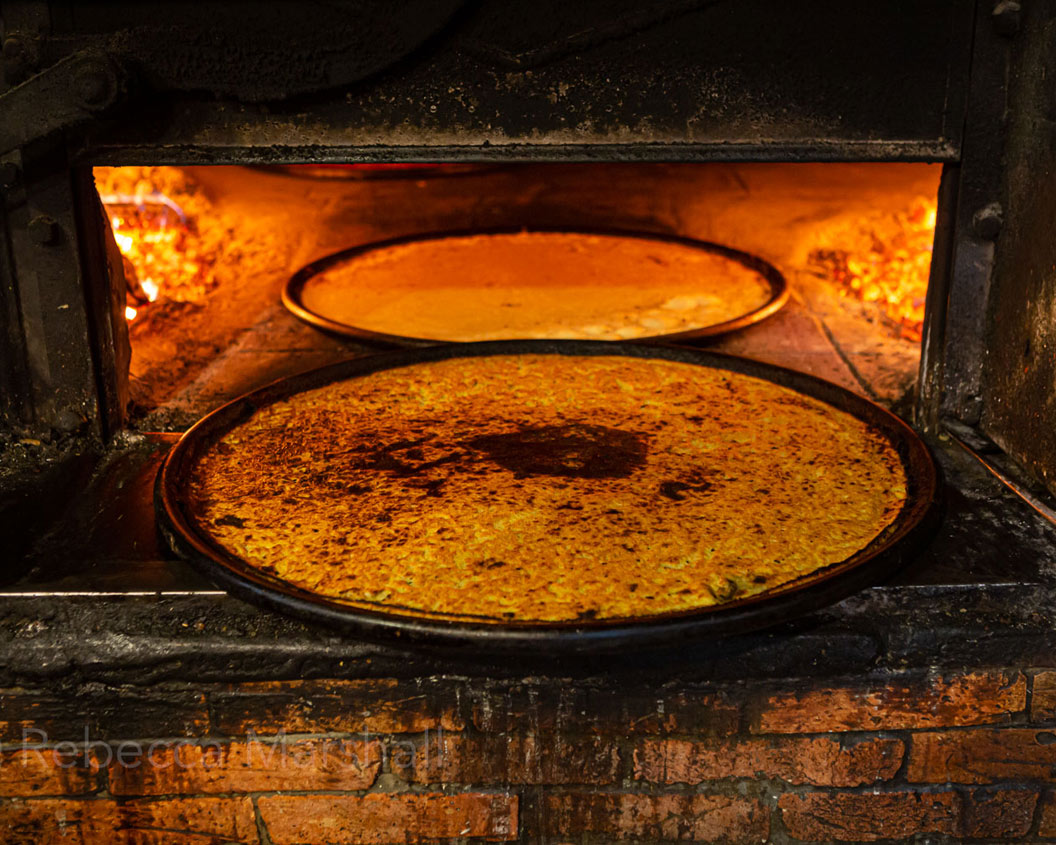
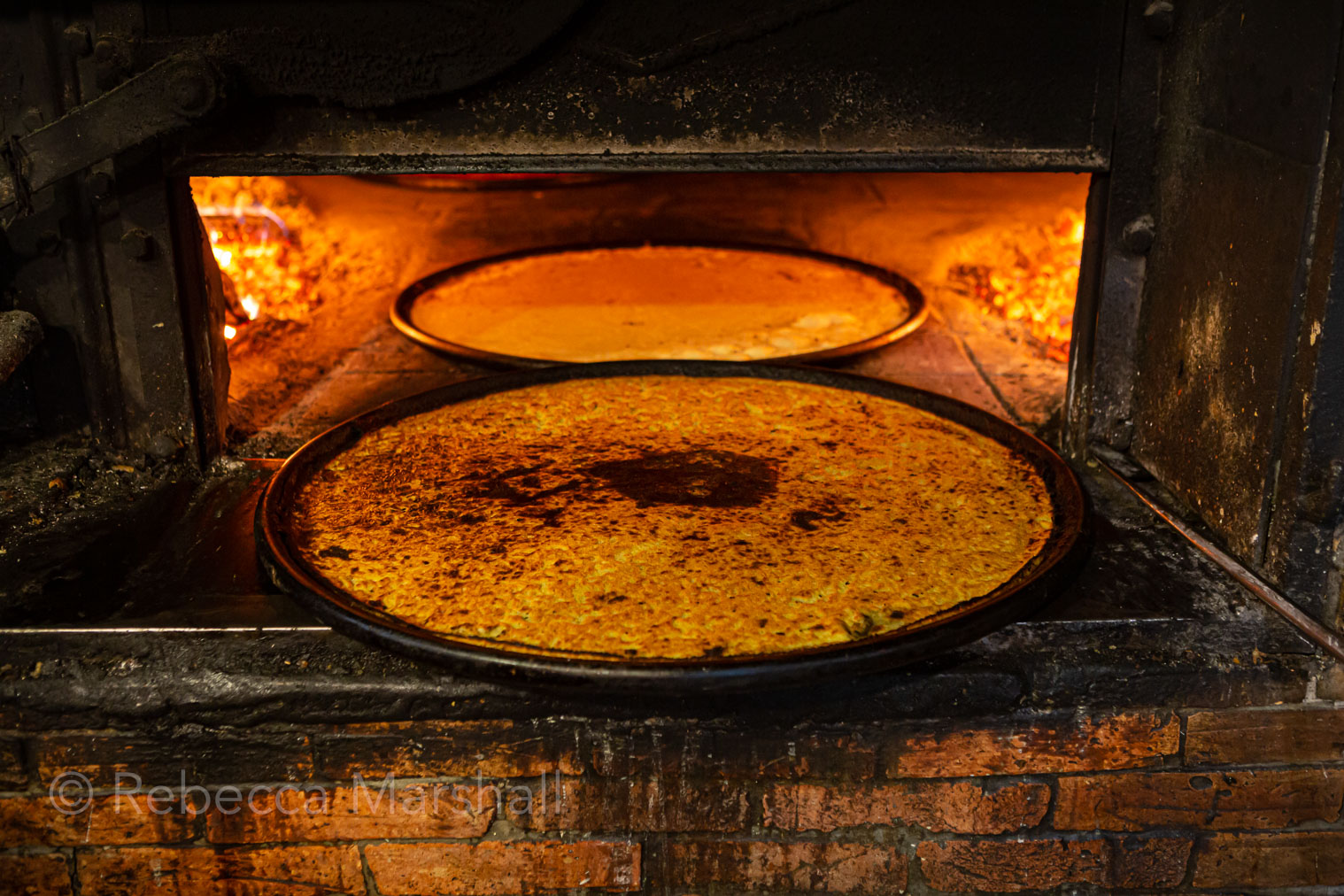
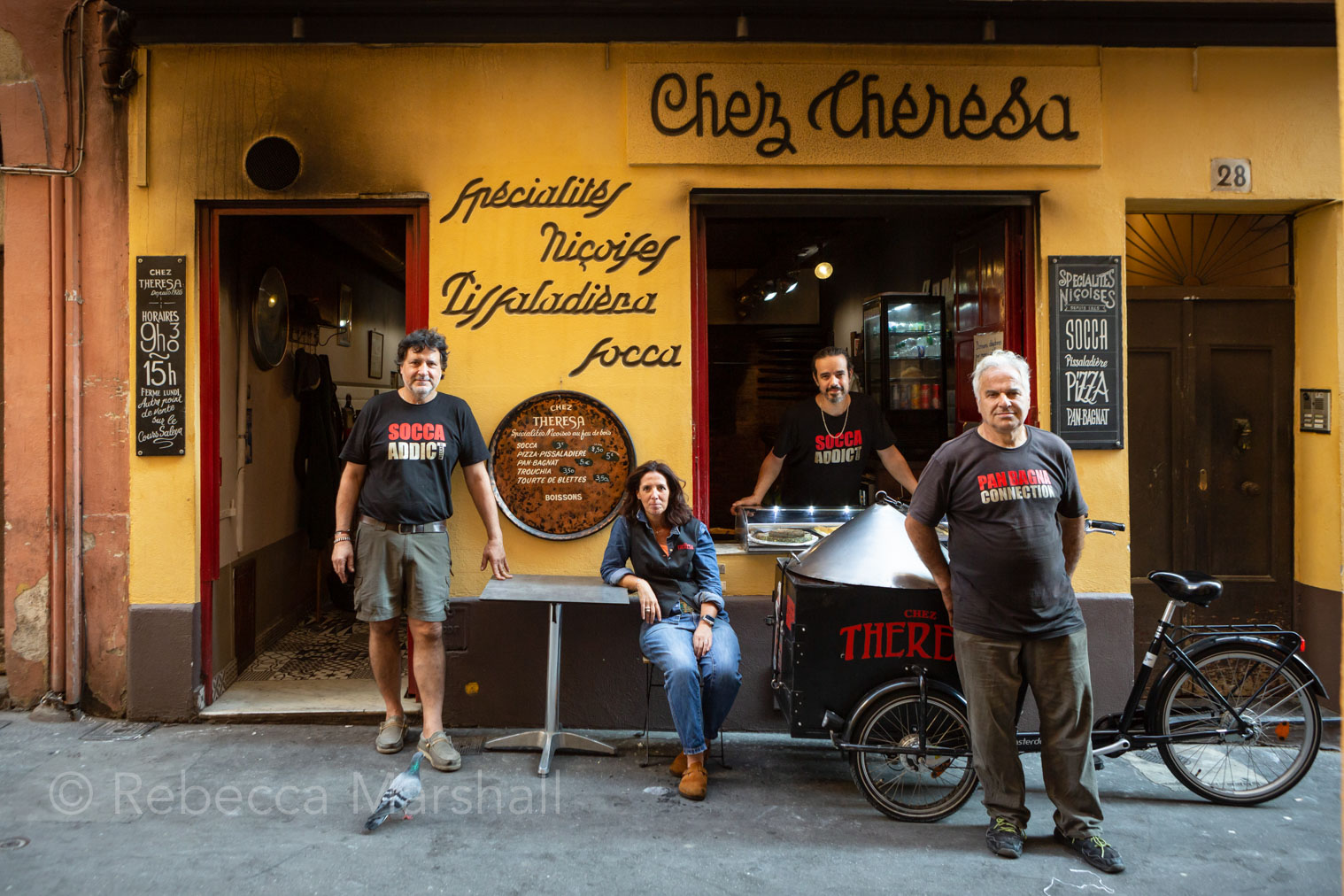
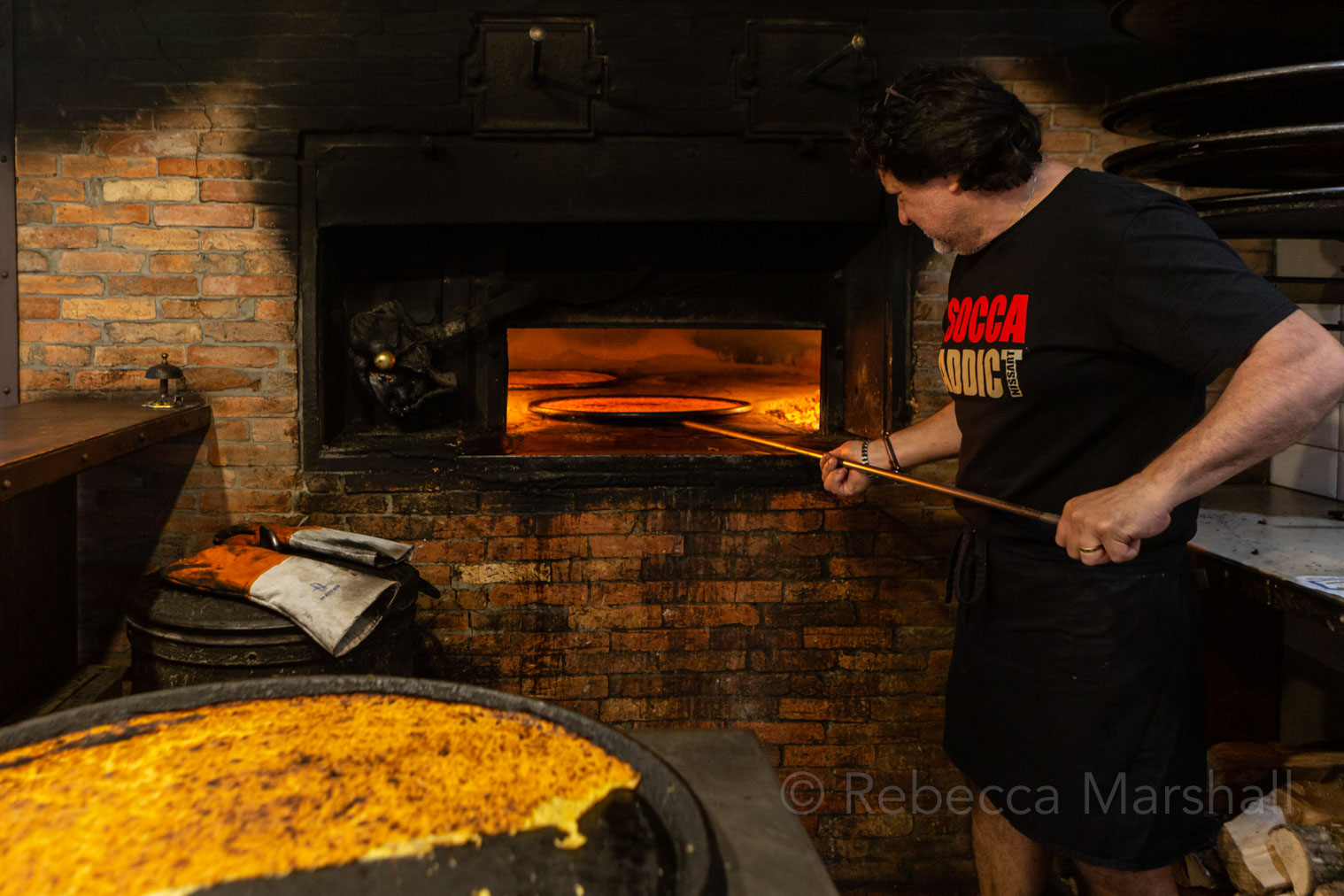
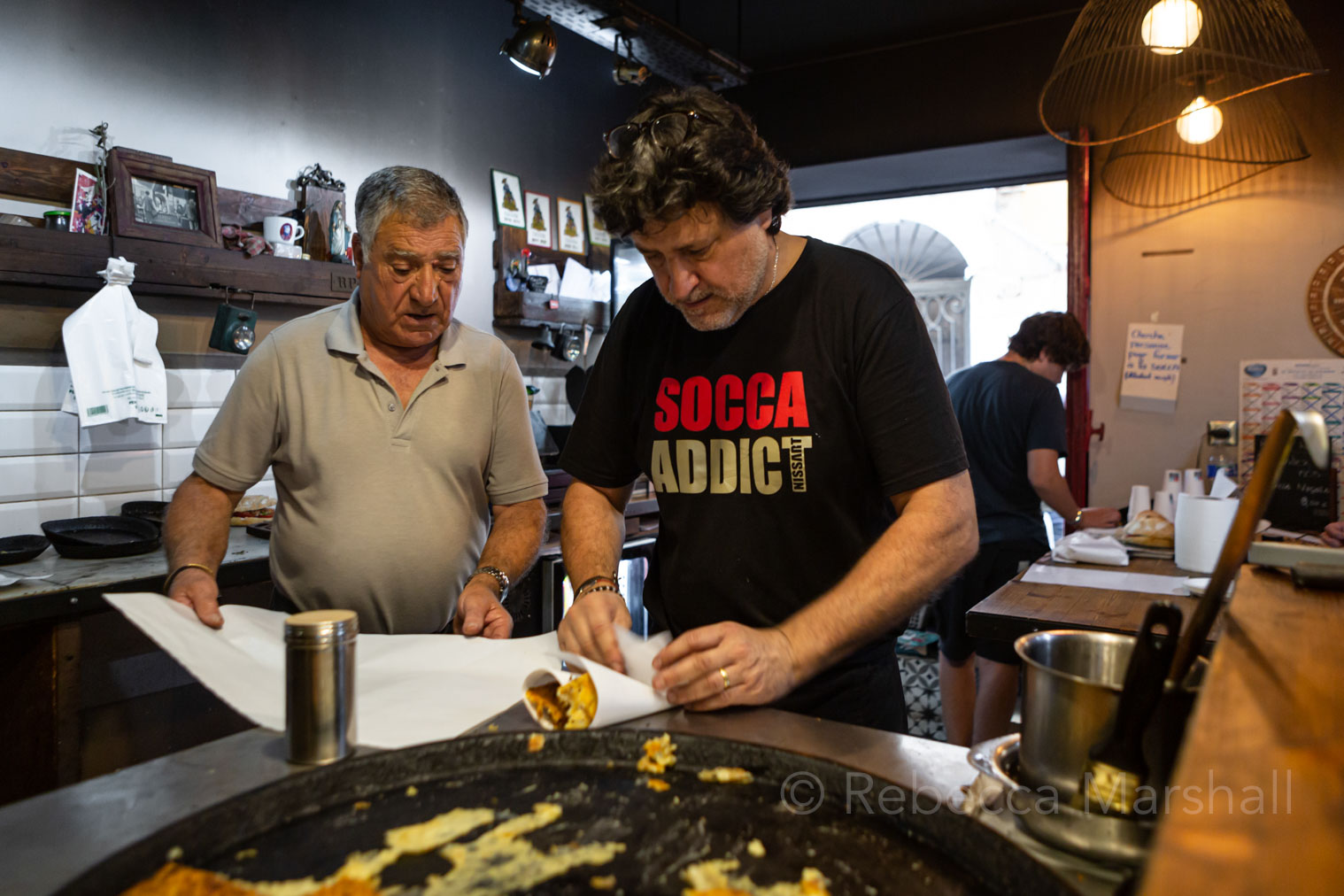
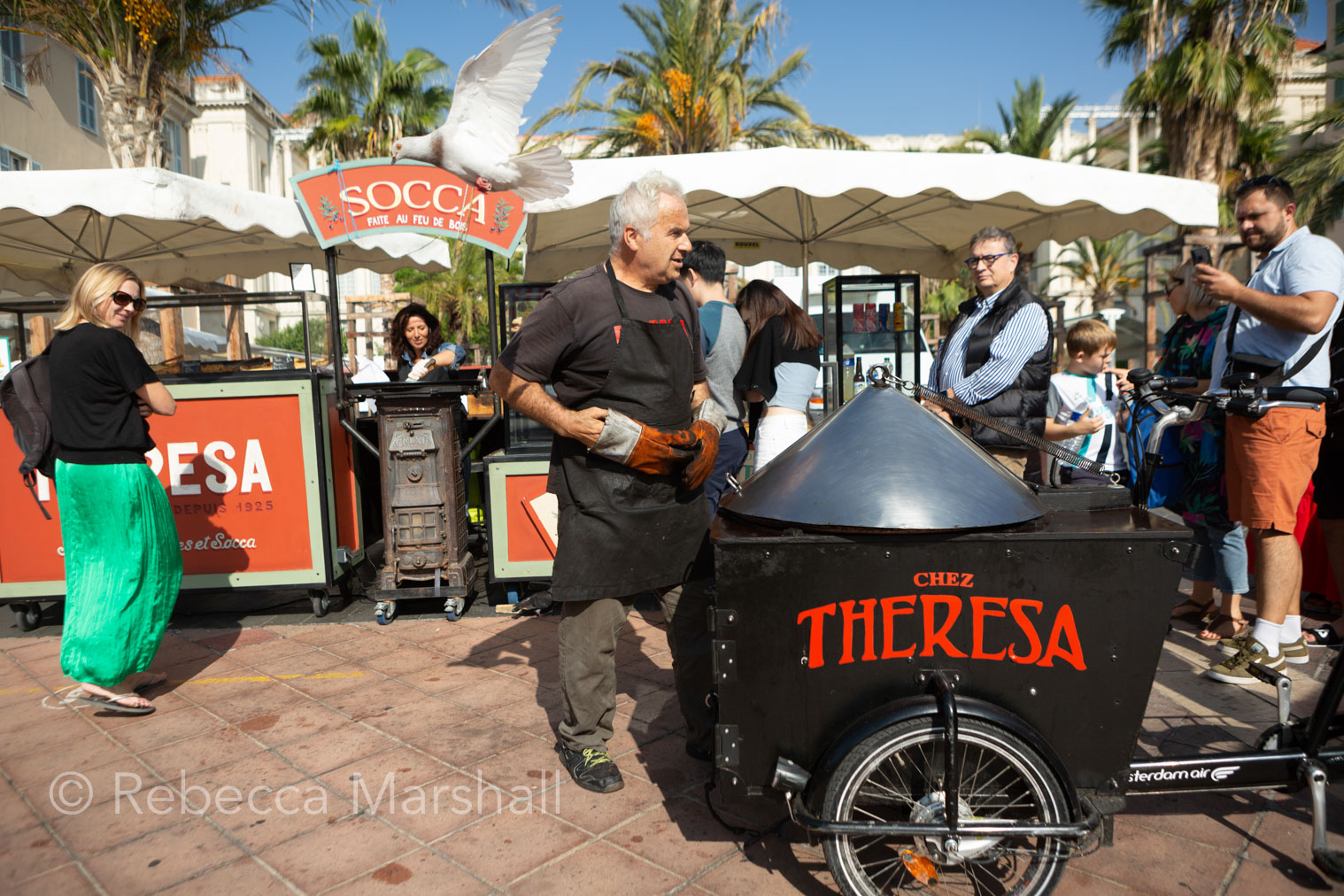
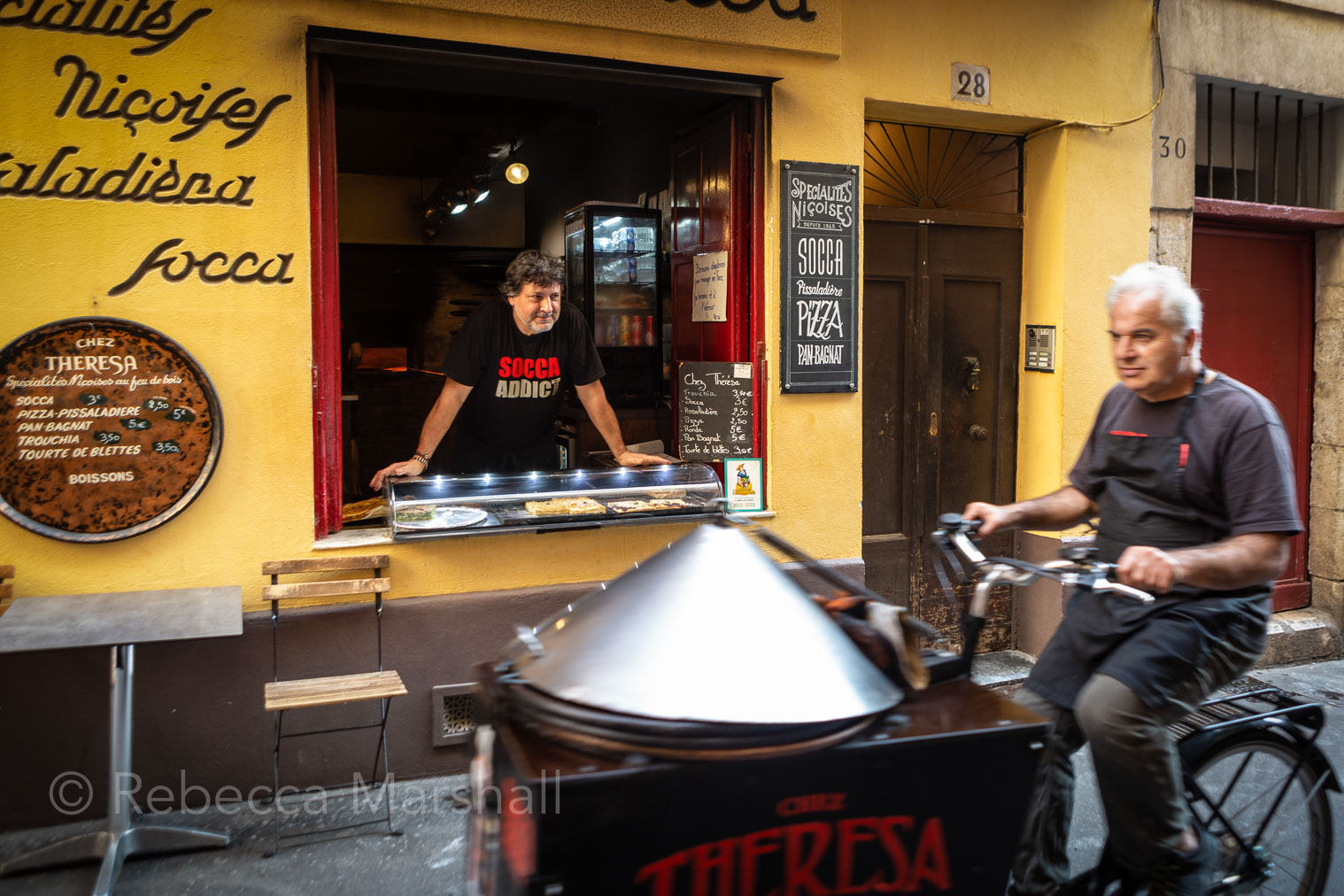
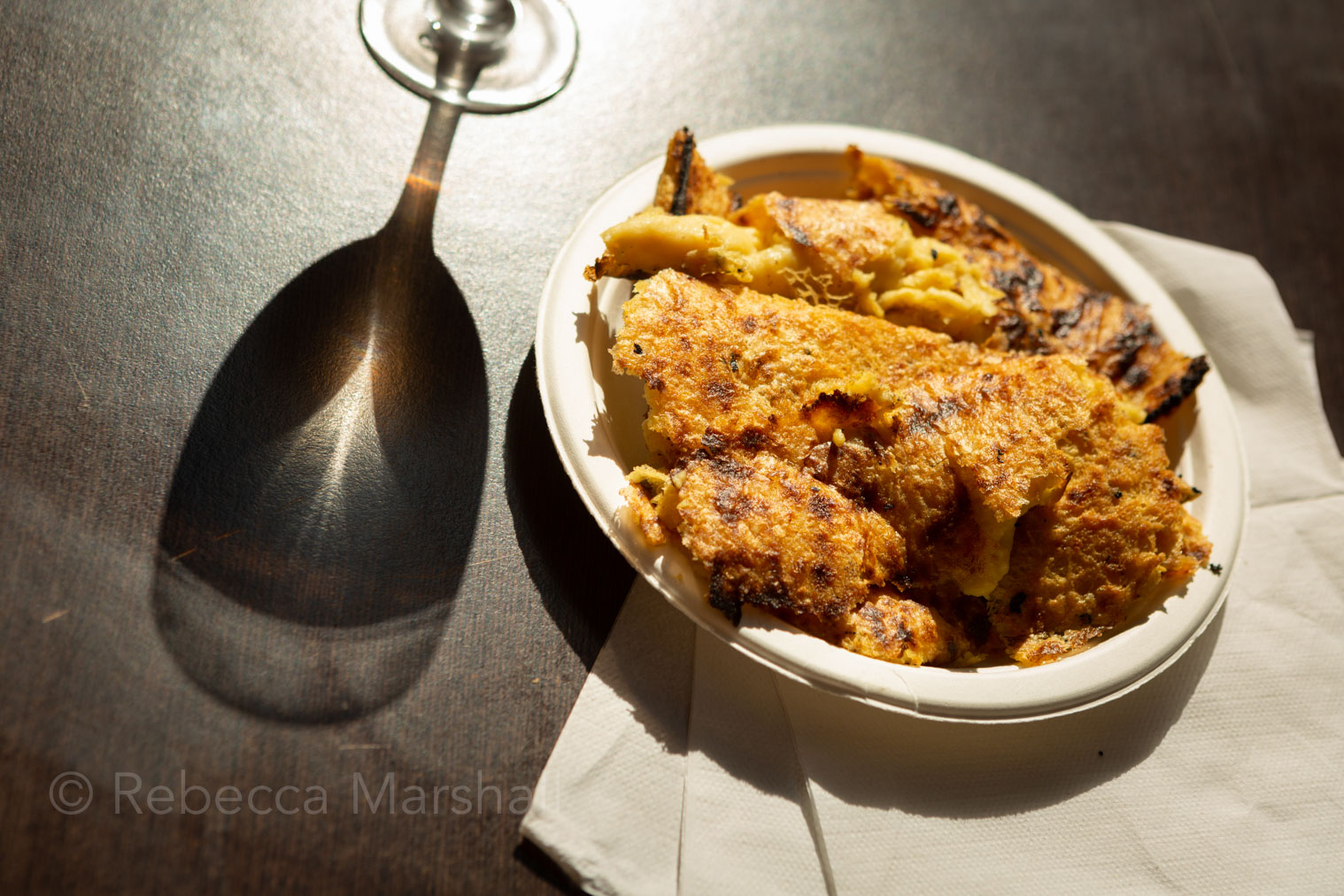
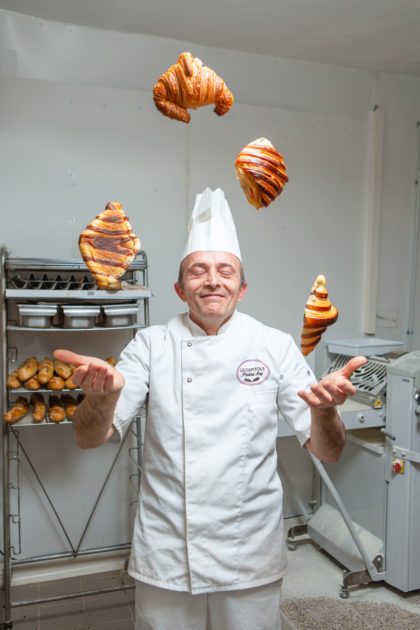
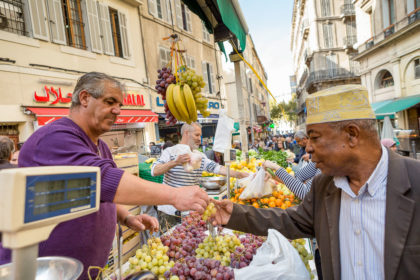
Tracy Santoni
Sep 17, 2024 at 12:56 am
Loved the article. Tasted my first Socca at chez Teresa in 2000, and have enjoyed it at various locations since. Great photography!